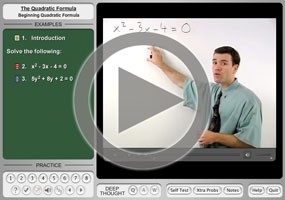The quadratic formula is a fundamental tool in algebra that provides a straightforward method for solving quadratic equations. If you’ve ever struggled to factor a quadratic or complete the square, the quadratic formula offers a reliable and universally applicable solution. In this guide, we’ll break down what the quadratic formula is, when to use it, how to apply it step-by-step, and explore its connection to the graphs of quadratic equations.
Understanding the Basics: Quadratic Equations
A quadratic equation is a polynomial equation of the second degree. The standard form of a quadratic equation is:
ax² + bx + c = 0where ‘a’, ‘b’, and ‘c’ are coefficients, and ‘x’ represents the variable we want to solve for. ‘a’, ‘b’, and ‘c’ are typically numbers, with ‘a’ not being equal to zero (otherwise, it would be a linear equation).
What is the Quadratic Formula?
The quadratic formula is derived from the method of completing the square and provides the solutions (also known as roots or zeros) for any quadratic equation in the standard form. The formula is stated as:
x = [-b ± √(b² - 4ac)] / (2a)This formula might look a bit intimidating at first, but once you understand its components and how to use it, you’ll find it to be a powerful problem-solving tool.
When Should You Use the Quadratic Formula?
While some quadratic equations can be solved by factoring or by taking the square root (in simpler cases), the quadratic formula is invaluable in several situations:
- When Factoring is Difficult or Impossible: Many quadratic equations are not easily factorable. The quadratic formula works for all quadratic equations, regardless of whether they can be factored easily.
- For Complex or Irrational Roots: The quadratic formula can find solutions even when they are irrational numbers (involving square roots that don’t simplify to whole numbers) or complex numbers. Factoring typically only yields rational roots.
- As a Universal Method: Even if a quadratic equation could be factored, using the quadratic formula is a consistent method that always works. This can be especially helpful in exam situations or when you want a quick and reliable solution without trying to factor.
- In Applied Problems: Many real-world problems in physics, engineering, and other fields result in quadratic equations that may not be factorable. The quadratic formula is essential for solving these practical applications.
In essence, while factoring and other methods have their place, the quadratic formula is the most versatile and dependable method for solving quadratic equations of the form ax² + bx + c = 0.
How to Use the Quadratic Formula: A Step-by-Step Guide
Using the quadratic formula involves a few straightforward steps. Let’s break it down:
-
Put the Equation in Standard Form: Ensure your quadratic equation is in the form ax² + bx + c = 0. Rearrange terms if necessary to match this form.
-
Identify a, b, and c: Once the equation is in standard form, identify the numerical values of the coefficients ‘a’, ‘b’, and ‘c’. Remember to include the signs (+ or -) of the coefficients.
-
Plug the Values into the Formula: Substitute the values of ‘a’, ‘b’, and ‘c’ into the quadratic formula:
x = [-b ± √(b² - 4ac)] / (2a) -
Simplify the Expression: Carefully simplify the expression following the order of operations (PEMDAS/BODMAS).
- First, calculate b².
- Then, calculate 4ac.
- Subtract 4ac from b² to find the discriminant (b² – 4ac).
- Take the square root of the discriminant.
- Calculate -b.
- Now you have two possible solutions, one using the plus (+) sign and one using the minus (-) sign before the square root.
- Divide both resulting numerators by 2a.
-
State the Solutions: You will typically get two solutions for ‘x’ from the quadratic formula due to the “±” sign. These are the roots of the quadratic equation.
Important Tips and Cautions:
- Signs Matter: Pay very close attention to the signs of ‘a’, ‘b’, and ‘c’ when substituting them into the formula. Incorrect signs are a common source of errors.
- Denominator: The entire numerator [-b ± √(b² – 4ac)] is divided by the entire denominator (2a). Make sure the division is applied correctly to the whole expression.
- Square Root: Remember to take the square root of the entire discriminant (b² – 4ac), not just parts of it.
- Order of Operations: Follow the correct order of operations throughout the simplification process to avoid mistakes.
- Discriminant: The discriminant (b² – 4ac) provides valuable information about the nature of the roots:
- If b² – 4ac > 0: There are two distinct real roots.
- If b² – 4ac = 0: There is exactly one real root (a repeated root).
- If b² – 4ac < 0: There are two complex roots (no real roots).
Example 1: Solving a Factorable Quadratic Equation
Let’s solve the quadratic equation x² + 3x – 4 = 0 using the quadratic formula. We know this equation can be factored as (x + 4)(x – 1) = 0, giving solutions x = -4 and x = 1. Let’s verify this with the quadratic formula.
Here, a = 1, b = 3, and c = -4. Plugging these values into the formula:
x = [-3 ± √(3² - 4 * 1 * -4)] / (2 * 1)
x = [-3 ± √(9 + 16)] / 2
x = [-3 ± √25] / 2
x = [-3 ± 5] / 2Now we consider both the plus and minus cases:
- Case 1: Plus (+)
x = (-3 + 5) / 2 = 2 / 2 = 1 - Case 2: Minus (-)
x = (-3 - 5) / 2 = -8 / 2 = -4
So, the solutions are x = 1 and x = -4, which match the solutions we found by factoring.
 Practice The Quadratic Formula on MathHelp.com
Practice The Quadratic Formula on MathHelp.com
Example 2: Solving a Non-Factorable Quadratic Equation
Let’s solve 2x² – 4x – 3 = 0 using the quadratic formula. Trying to factor this equation quickly reveals that it’s not easily factorable with integer coefficients.
Here, a = 2, b = -4, and c = -3. Plugging these values into the formula:
x = [-(-4) ± √((-4)² - 4 * 2 * -3)] / (2 * 2)
x = [4 ± √(16 + 24)] / 4
x = [4 ± √40] / 4We can simplify √40 as √(4 * 10) = 2√10.
x = [4 ± 2√10] / 4Divide both terms in the numerator by 4:
x = 1 ± (√10) / 2So, the exact solutions are x = 1 + (√10) / 2 and x = 1 – (√10) / 2. If we need decimal approximations, we can use a calculator:
- x ≈ 1 + (3.162) / 2 ≈ 1 + 1.581 ≈ 2.581
- x ≈ 1 – (3.162) / 2 ≈ 1 – 1.581 ≈ -0.581
Rounding to two decimal places, we get x ≈ 2.58 and x ≈ -0.58.
The Quadratic Formula and X-Intercepts
The solutions to a quadratic equation ax² + bx + c = 0 represent the x-intercepts of the parabola defined by the equation y = ax² + bx + c. X-intercepts are the points where the parabola crosses the x-axis (where y = 0).
When you solve a quadratic equation using the quadratic formula, you are essentially finding the x-values where the parabola intersects the x-axis.
For example, in our first example, x² + 3x – 4 = 0 had solutions x = 1 and x = -4. If we graph the parabola y = x² + 3x – 4, we will see that it crosses the x-axis at x = 1 and x = -4.
In the second example, 2x² – 4x – 3 = 0 had solutions approximately x ≈ 2.58 and x ≈ -0.58. The graph of y = 2x² – 4x – 3 would intersect the x-axis at approximately these x-values.
This connection between algebraic solutions and graphical representation is a powerful concept in mathematics, linking the roots of an equation to the visual representation of the corresponding function.
Conclusion
The quadratic formula is an indispensable tool for anyone studying algebra and beyond. It provides a reliable method for solving quadratic equations, regardless of their factorability or the nature of their roots. By understanding what the quadratic formula is, when to use it, and how to apply it correctly, you equip yourself with a fundamental skill for mathematical problem-solving and a deeper understanding of quadratic equations and their graphs. Practice using the formula with various examples to build your confidence and mastery.

